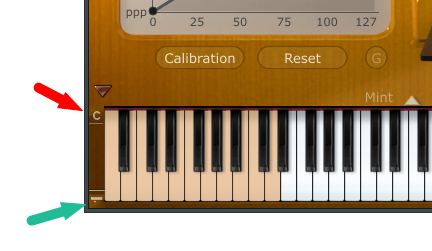Gaston wrote:MannyF wrote:I realise the lowest note you can play on a guitar is the low E string but I was wondering, since it's a modeled instrument, if there is any way to play notes lower than that? Some times I find myself wanting to go lower but it can't.
You may change the tuning (e.g. Drop D) :
https://ahp.li/85f58bd18b95d86e1105.jpg
Or use "Guitare a la piano" preset which allows you to use full 88 keys of your keyboard.
Example :
https://hearthis.at/xnwdv7yv/piaghitaralano/
Thanks Gaston! Your reply pointed me in the right direction. After loading "Guitare a la piano", I noticed some icons had changed on the virtual keyboard:

It seems any preset supports this feature. There "+/-" button (green arrow) toggles between original and extended note range, pretty much does what it says on the tin and makes the whole 88-key virtual keyboard playable disregarding the physical limitations of instrument being modeled. When the button displays a "-" that means the extended range is active. The button at the top (red arrow) cycles through three types of keyboards: C = Chromatic, G = Guitar, D = Diatonic; click it until you see "C", which gives you 88 piano keys and access to the lower registers of the extended range. There appear to be some limitations/compromises which at the moment I don't think can be overcome:
1. Unless you use Guitar mode you lose the guitar articulation section entirely, which I can't fathom because there are still unused notes left that could have been used for this.
2. Guitar articulations don't work when I enable the guitar-style keyboard unless it's a guitar patch. I think it would have been interesting from a sound design perspective to be able to use those features with, say, pianos, even if it sounds unnatural, it has a valid place in a sound design context.
3. Pianoteq ignores any notes outside the range of the 88-key virtual piano keyboard.
4. Some Pianos, such as the Steinway Model D, feature a 105-key range instead of the usual 88-key. When this is the case, Pianoteq displays arrow buttons either side of the virtual keyboard to enable scrolling (pic below). If some pianos can have a 105-note range, why not a 128-note range? And why give users the option of a range greater than 88 notes for pianos that originally only have 88 notes (at least in extended range mode)? I mean, who cares if it deviates from the original? Isn't that the point of models, to extrapolate physics and go beyond? I think this would be of interest from a sound design perspective.


